Basalt is a very common dark-colored volcanic rock composed of calcic plagioclase (usually labradorite), clinopyroxene (augite) and iron ore (titaniferous magnetite). Basalt may also contain olivine, quartz, hornblende, nepheline, orthopyroxene, etc. Basalt is a volcanic equivalent of gabbro.
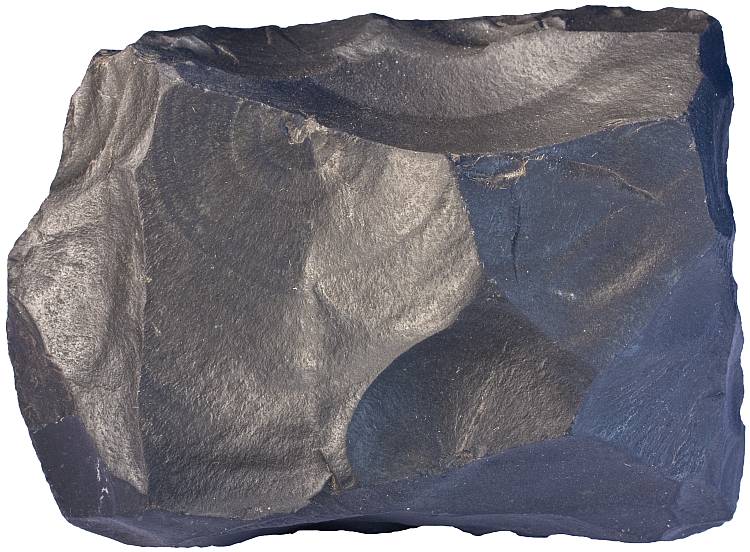
Basalt is a fine-grained and dark-colored rock. Black color is given to basalt by pyroxene group mineral augite. Width of the sample is 12 cm.
Basalt is usually black or dark gray and relatively featureless. It is composed of mineral grains which are mostly indistinguishable to the naked eye. Basalt may also contain volcanic glass. Basalt may contain phenocrysts (larger crystals within fine-grained groundmass) and vesicules (holes that were filled by volcanic gases).
Black color is given to basalt by pyroxene and magnetite. Both of them contain iron and this is the reason why they are black. So this is iron again which is responsible for the coloration of basalt. Plagioclase, volumetrically usually the most important constituent, is mostly pale gray in color.
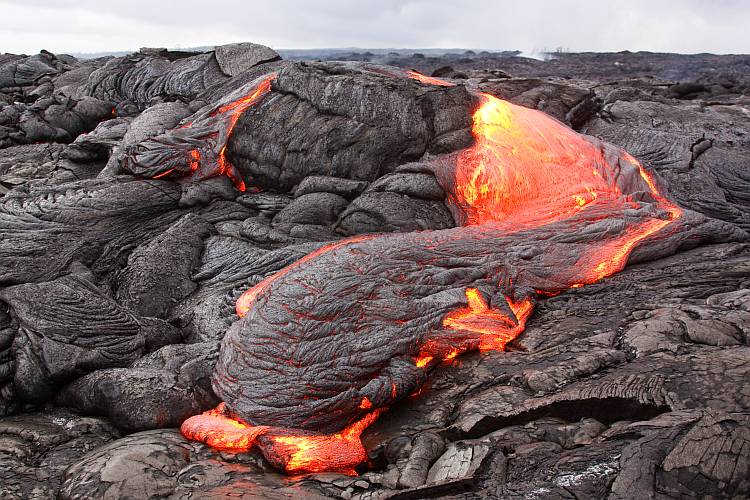
Basalt lava flowing in Hawai’i (Kilauea volcano, Pu’u O’o vent).
Basalt is a major rock type that occurs in virtually every tectonic setting. Basalt is clearly the most common volcanic rock on Earth and basaltic rocks (including gabbro, diabase and their metamorphosed equivalents) are the most common rocks in the crust2. Basalt is also common on the Moon and other rocky planets of the Solar System.
What makes basalt so common? Basalt is the original constituent of the crust from which almost all other rock types have evolved. Basalt forms when mantle rocks (peridotite) start to melt. Rocks melt incongruently. It basically means that melt that forms has a different composition from the source rocks. Of course, it can only happen if rocks melt only partially, but this is exactly what happens in the upper mantle. It melts partially to yield basaltic magma which is less dense and rises upward to form new oceanic crust in mid-ocean ridges or volcanoes and intrusives (dikes, sills) in many other tectonic regimes. Basalt is the source rock of other more evolved volcanic rocks like dacite, rhyolite, etc.
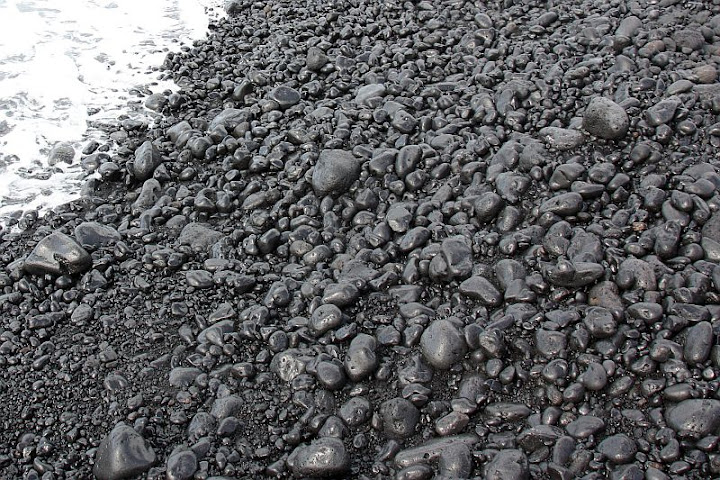
Basalt pebbles near the southern tip of La Palma slowly transforming into black sand typical to volcanic oceanic islands.

Basalt sample collected near the Giant’s Causeway, Northern Ireland. Width of sample 8 cm.
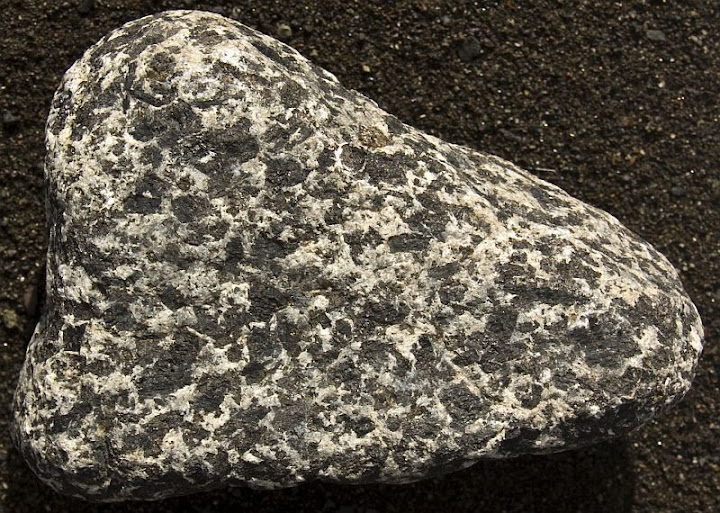
Gabbro is a coarse-grained (intrusive) equivalent of basalt. This sample of gabbro comes from La Plama. La Palma is an oceanic island, but some parts of it are uplifted and there are deep ravines like Caldera de Taburiente that cuts deep into the interior of the island and allows intrusive rocks like gabbro to be exposed. Width of sample 10 cm.
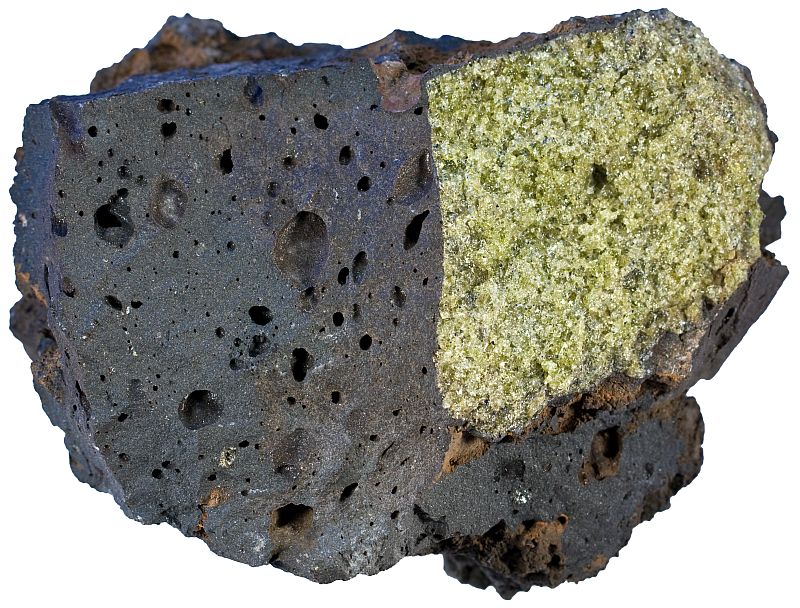
Basaltic rocks may carry xenoliths from the mantle. Here is a bright green dunite xenolith inside basalt from Hawai’i. Width of sample 8 cm.
Classification

Basalt has a strict chemical definition. It is defined in the TAS diagram shown above. Basalt is an igneous rock that contains more than 45 and less than 52% of SiO2 and less than five percent of total alkalies (K2O + Na2O)3.
Neighboring rock types like basaltic andesite, basanite, picrite (picrobasalt), trachybasalt and even more distant rocks like phonotephrite or andesite may have very similar look and can be easily mistaken for basalt in many cases.
Basalt is widespread in many tectonic regimes, but there are slight variations in chemical composition which allow more precise classification. MORB is an acronym for “mid-ocean ridge basalt” and OIB for “oceanic island basalt”. MORB is a result of partial melting of the upper mantle which is already recycled many times while OIB is at least partly from more deeper part of the mantle (deep-sourced mantle plumes that feed hot spots like Hawai’i or the Canary Islands) and is therefore less depleted in incompatible chemical elements.

Andesite is similar to basalt, but it contains more silica and is generally lighter in color. White crystals are plagioclase phenocrysts, but they contain less Ca and more Na than plagioclase in basalt does. Andesite is very common product of subduction zone volcanism. Santorini, Greece. Width of sample 7 cm.
Composition
Average chemical composition of basalt determined by 3594 chemical analyses of basaltic rocks2 (numbers are mass percents, recalculated volatile-free to total 100%):
SiO2 — 49.97
TiO2 — 1.87
Al2O3 — 15.99
Fe2O3 — 3.85
FeO — 7.24
MnO — 0.20
MgO — 6.84
CaO — 9.62
Na2O — 2.96
K2O — 1.12
P2O5 — 0.35
Minerals that host these chemical elements (chemical composition of igneous rocks is traditionally expressed in oxides) are augite, plagioclase and titaniferous magnetite. These minerals are difficult to demonstrate because they are too small to be seen in typical basalt, but some basaltic rocks are porphyritic (lots of porphyritic rocks can be seen here: porphyry) and show some of these minerals nicely (unfortunately not magnetite, though).
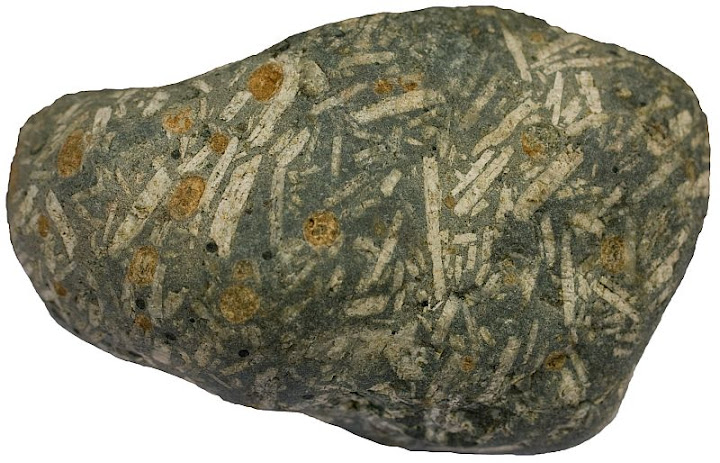
Basalt porphyrite from the Isle of Mull, Scotland with many plagioclase phenocrysts. The rock is 8 cm in length.

Porphyritic basaltic rock from Tenerife. Phenocrysts are plagioclase (white) and augite (black). Width of sample 14 cm.

Magnetite crystals are always microscopic in basalt, but sometimes they form black stripes in light-colored sand. Here are heavy minerals (mostly magnetite) as a residue of weathering of basaltic rocks. White Park Bay, Northern Ireland.

Basaltic rock (most likely basanite) from Caldera de Taburiente, La Palma. Black is pyroxene augite, orange is olivine or more precisely what is left of it. Orange patches are former olivine crystals that are now composed of a mixture of silicates and iron oxides which is known as iddingsite. Olivine is a common mineral in many basaltic rocks. Width of view 10 cm.

Another basalt (chemically probably picrobasalt) with lots of olivine (fresh olivine is bright green, but it gets more and more yellow as it weathers). Oahu, Hawai’i. Width of sample 6 cm.
Basalt in the field
Subaerial basalt forms lava flows or pyroclastic fields and cones. Two main types of basaltic lava flows are aa lava and pahoehoe lava.
Aa lava has rough rubbly irregular crust while pahoehoe is smooth. Lava crust of aa type is broken into pieces while pahoehoe retains its continuity. Both lava flow types are massive beneath the crust and this massive interior may be columnar. Columns are separated from each other by narrow cracks which form because cooling basaltic magma contracts. Cracks start to form at the surface and propagate deeper as lava cools. Submarine basalt usually forms pillows. Pillow basalt forms as a result of very rapid cooling. Outer part of forming pillow cools very quickly in contact with cold seawater while the interior still fills with molten lava.
Basalt mostly forms lava flows because it is among the least viscous magma types and therefore does not generate explosive volcanic eruptions, but sometimes pyroclastic material is formed when magma contains more volcanic gases. Basaltic rocks can be thrown out of volcanic vents as lapilli (singular: lapillus) and volcanic bombs. Basaltic volcanoes are fed by dikes (planar intrusive rock bodies when solidified that cut through other rocks) and sills (similar to dike but generally parallel to preexisting bedding planes).
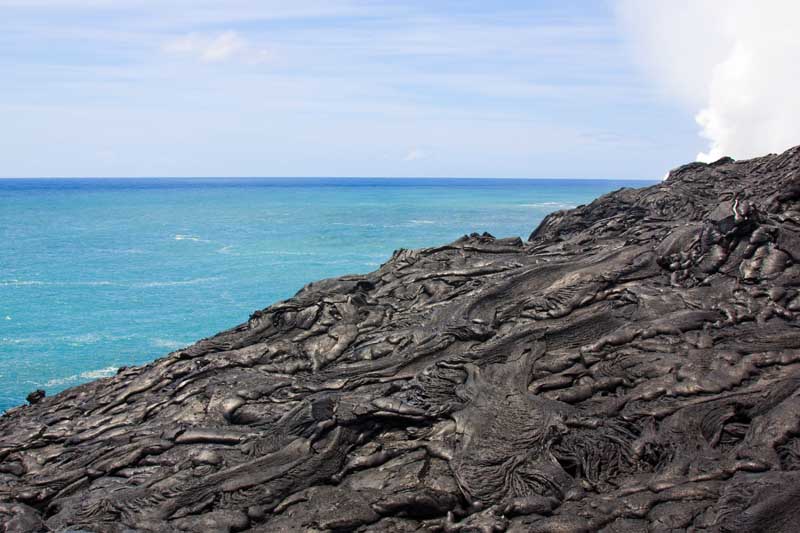
Basaltic lava flows of Kilauea volcano in Hawai’i.

Aa lava in the foreground. La Palma, Canary Islands.

Pahoehoe lava (ropy lava). La Palma, Canary Islands.
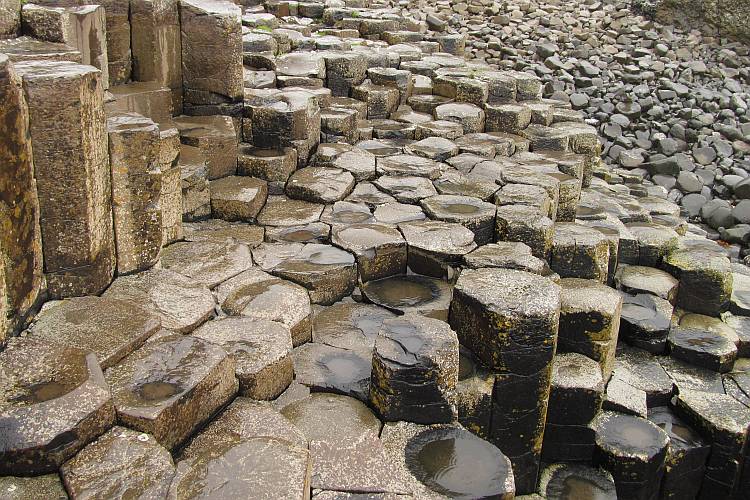
Basalt columns. Giant’s Causeway, Northern Ireland.
Pillow lava near Fasoula, Troodos ophiolite, Cyprus. Pillow lava is very common on Earth, but difficult to find because almost all of it is on the ocean floor. Examples can be found on land usually where former ocean floor is tectonically squeezed between two blocks of continental crust.

Scoriaceous lapillus from Etna, Italy. Despite being 5 cm in width it weighs only 15 grams because it is filled with gas bubbles (vesicules). Similar rock type with a felsic composition is pumice.
Sometimes dikes are so close to each other that the whole outcrop is composed of them. These sheeted dikes in Cyprus once fed volcanoes on the ocean floor.

Dikes are composed of basalt and diabase. Diabase is nothing more than coarse-grained basalt. Here is a contact between basalt (on the left) and diabase in Cyprus. The basaltic dike is fine-grained because it is younger and was chilled (it lost heat rapidly to the diabase dike on the right).
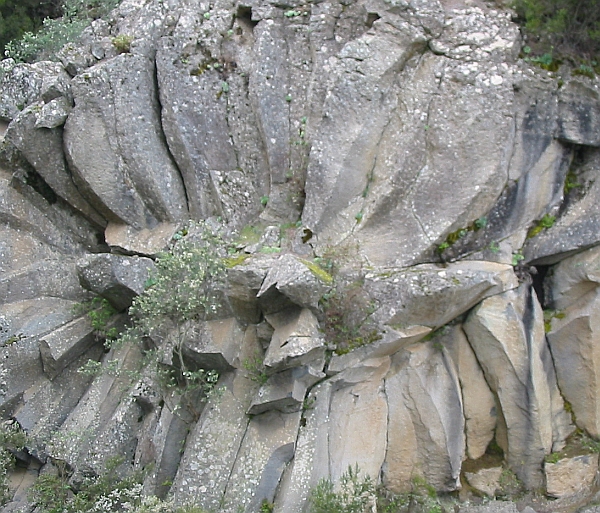
Columns in basalt are perpendicular to the cooling front. In this case it is evident that basalt formed a tube (filled lava tunnel). Such conduits are common phenomena in volcanic islands and provide a way for the volcano to enlarge itself because magma can flow great distances inside such thermally insulated tubes before solidifying. Tenerife, Canary Islands.

Dikes and sills are often visible on the ground and may become notable landforms. Salisbury Crags in Edinburgh is basaltic sill.
Metamorphism and weathering
Basalt is largely composed of minerals with little resistance to weathering. Hence, basalt as a whole also tends to disintegrate faster than granite and other felsic rock types. Magnetite is one of the most resistant common minerals in basalt and forms the bulk of heavy mineral sands. Other minerals disintegrate and release their components to water as ions or form clay minerals. Iron and aluminum are among the least mobile ions and therefore tend to form laterite deposits enriched in these elements.
Basalt metamorphoses to a number of different rock types, depending on pressure, temperature, and the nature of volatile compounds that react with minerals in basalt. Most common metamorphic rocks with basaltic protolith are chlorite schist, amphibolite, blueschist, and eclogite.

Black sand forms in volcanic islands when quartz and biogenic grains are not available. Here is a basaltic cliff and black sand on La Palma, Canary Islands.

Chlorite schist is a low-grade metamorphosed mafic igneous rock, often with a basaltic protolith. Iron-bearing green sheet silicate mineral chlorite gives slaty cleavage to the rock. Width of sample 13 cm.
Etymology
The term “basanite” was already used in antiquity and “basalt” is probably a faulty transcription of basanite. It was German scholar Agricola (Georg Bauer) who first mentioned “basalt” in 1546. He referred to black columnar rocks from Stolpen (near Dresden in Germany) which is indeed basalt even according to modern classification principles1.
References
1. Tomkeieff, S. I. (1983). Dictionary of Petrology. John Wiley & Sons.
2. Best, Myron G. (2002). Igneous and Metamorphic Petrology, 2nd Edition. Wiley-Blackwell.
3. Le Maitre, R. W. (2005). Igneous Rocks: A Classification and Glossary of Terms: Recommendations of the International Union of Geological Sciences Subcommission on the Systematics of Igneous Rocks, 2nd Edition. Cambridge University Press.
It is good note taking I delighatedful.
You said that Basalt is a volcanic equivalent gabbro.does gabbro volcanic igneous rock?
How many tests are required for stonewool production?
Should we go thru all 3594 chemical analyses of basaltic rocks?
These 3594 are taken from scientific literature. Stonewool production shouldn’t have anything to do with these numbers.
pleas share 5 main types of basalt rock 1 flood 2 alkali 3 thoeiiltic 4 columnar 5 pillow